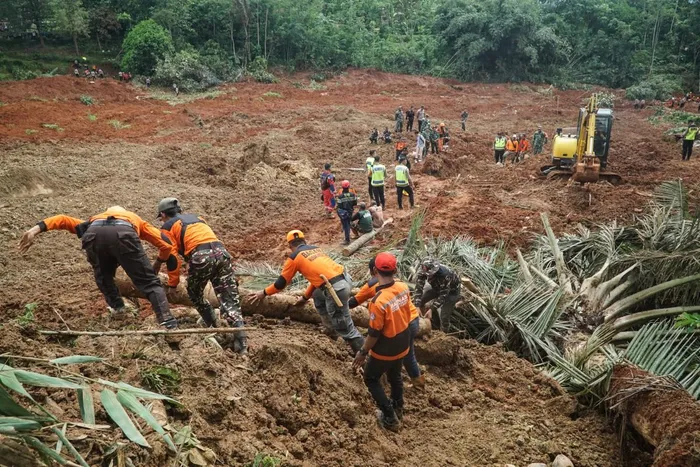COP30: The weather is natural, the disaster is not
POOR PLANNING

Rescuers search for survivors after a landslide in Central Java, on November 14. The writer says the scale of devastation in natural disasters hinges on human decisions, rather than the disaster itself.
Image: AFP
With COP30 closing this week, one truth has come sharply into focus: climate extremes are natural, but disasters are not. The 2025 United Nations Climate Change Conference has highlighted how planning, infrastructure and preparedness determine whether communities withstand or are overwhelmed by floods, storms, droughts and heatwaves.
The problem with the phrase “natural disaster”
Every time the news breaks with footage of devastation – homes swept away, bridges down, lives upended – there’s one phrase that always comes up: natural disaster. But here’s the thing: the weather’s natural, but the disaster isn’t.
Floods, storms, droughts and earthquakes are natural hazards. They are part of the Earth’s systems. But whether those hazards become disasters is shaped entirely by people, by where we build, how we plan, how we maintain infrastructure and whether communities have warning, transport and trust.
Scaled-up climate adaptation and disaster risk reduction have been central to the COP30 agenda, and this has been reinforced throughout the negotiations. While extreme weather is undeniably intensifying in a warming world, the scale of devastation still hinges on human choices: how we plan, build, invest and prepare.
Why accountability matters
In disaster risk management, a disaster is defined by its impact on people, property, infrastructure and the environment. A storm is not a disaster on its own; it becomes one when it intersects with poor planning, inadequate maintenance or vulnerable communities living in high-risk areas.
Calling something a “natural disaster” suggests inevitability – as if nothing could have been done to prevent or reduce the loss. That language erases accountability. Many of the disasters South Africa experiences are decades in the making: neglected stormwater systems, informal housing in flood-prone zones, deforestation, building on floodplains and overlooked signs of failing infrastructure. Nature may trigger the event, but people shape the consequences. And when disaster strikes, the most vulnerable are the ones who suffer most. Preparedness is the difference between danger and disaster
Across South Africa and in communities further afield, such as rural Ghana and Samoa, the same truth emerges: preparedness saves lives. It doesn’t require a high-tech centre or million-rand equipment. Sometimes it’s a simple communication system, a school siren, a ward councillor with a plan, or a family go-bag packed with essentials.
In Umlazi in KwaZulu-Natal, one councillor’s swift action during the floods – coordinating evacuations, arranging transport and relaying warnings – made an enormous difference. Not everyone followed the guidance, often because fear, past trauma or mistrust kept them rooted, but those who acted early were safer for it.
These are the lessons COP30 is amplifying. Disaster risk reduction succeeds or fails at the local level. Early-warning systems, inclusive communication, trust-building and last-mile preparation are among the most effective tools available. Resilience grows through everyday habits, planning and relationships long before an emergency siren sounds.

Yolandi Meyer, Disaster Risk Management Consultant: Climate Resilience, Water at Atana
Image: Supplied
The funding problem: too much after, too little before
One of the biggest obstacles remains the way the world funds disasters. Money typically arrives after a catastrophe has already struck. Relief and recovery are politically visible.
Negotiators at COP30 are under growing pressure to rebalance this, because it is now widely accepted that adaptation and prevention save far more lives and cost far less than rebuilding afterwards.
Resilience often isn’t about enormous budgets at all. It’s about co-ordination: functioning early-warning systems, realistic transport plans, community awareness campaigns, ward-level risk mapping and enough trust that if leaders say, “It’s time to go,” people go.
Resilience starts in the household
Still, resilience cannot be government’s task alone. Every household plays a role in understanding the hazards around them, knowing where to go during an emergency and talking openly about plans with their children. Disaster readiness is something communities build together. It becomes part of how we live, not just how we respond when the sky darkens.
In South Africa’s disaster management circles, there’s a phrase we repeat often: it’s everybody’s business. And it is. Extreme weather may be driven by a changing climate, but disasters arise from the systems we design, the choices we make and the preparedness we prioritise.
As COP30 emphasises, it is time to stop treating disasters as unavoidable and start treating resilience as essential – because there is no such thing as a natural disaster, only natural hazards meeting unprepared societies.
Yolandi Meyer is a disaster risk specialist at Atana Engineering
Related Topics: